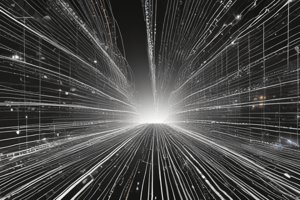Podcast
Questions and Answers
Explain the three techniques involved in digital-to-digital conversion.
Explain the three techniques involved in digital-to-digital conversion.
The three techniques involved in digital-to-digital conversion are line coding, block coding, and scrambling.
What is the purpose of line coding in data communication?
What is the purpose of line coding in data communication?
The purpose of line coding is to convert a string of 1’s and 0’s (digital data) into a sequence of signals that denote the 1’s and 0’s.
Differentiate between data rate and signal rate in digital transmission.
Differentiate between data rate and signal rate in digital transmission.
Data rate defines the number of data elements (bits) sent in 1 sec, while signal rate is the number of signal elements sent in 1 sec. The data rate is sometimes called the bit rate; the signal rate is sometimes called the pulse rate, the modulation rate, or the baud rate.
When is block coding and scrambling needed in digital-to-digital conversion?
When is block coding and scrambling needed in digital-to-digital conversion?
What are the units of measurement for data rate and signal rate in digital transmission?
What are the units of measurement for data rate and signal rate in digital transmission?
Flashcards
Line Coding
Line Coding
The process of converting a digital data stream into a sequence of signals suitable for transmission over a physical medium.
Block Coding
Block Coding
A type of line coding where multiple bits of data are encoded into a single signal element.
Scrambling
Scrambling
A technique used to manipulate the data stream to ensure that there are enough transitions to maintain clock synchronization.
Data Rate (Bit Rate)
Data Rate (Bit Rate)
Signup and view all the flashcards
Signal Rate (Baud Rate)
Signal Rate (Baud Rate)
Signup and view all the flashcards





